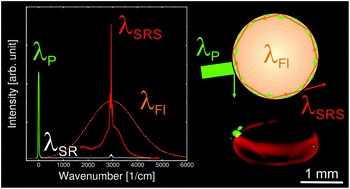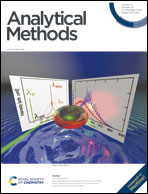Stimulated Raman scattering by intracavity mixing of nanosecond laser excitation and fluorescence in acoustically levitated droplets†
Abstract
Raman spectroscopy is becoming a commonly used, powerful tool for structural elucidation and species identification of small liquid samples, e.g. in droplet-based digital microfluidic devices. Due to the low scattering cross sections and the temporal restrictions dictated by the droplet flow, however, it depends on amplification strategies which often come at a cost. In the case of surface-enhanced Raman scattering (SERS), this can be an enhanced susceptibility towards memory effects and cross talk, whereas resonant and/or stimulated Raman techniques require higher instrumental sophistication, such as tunable lasers or the high electromagnetic field strengths which are typically provided by femtosecond lasers. Here, an alternative instrumental approach is discussed, in which stimulated Raman scattering (SRS) is achieved using the single fixed wavelength output of an inexpensive diode-pumped solid-state (DPSS) nanosecond laser. The required field strengths are realized by an effective light trapping in a resonator mode inside the interrogated droplets, while the resonant light required for the stimulation is provided by the fluorescence signal of an admixed laser dye. To elucidate the underlying optical processes, proof-of-concept experiments are conducted on acoustically levitated droplets, mimicking a highly reproducible and stable digital fluidic system. By using isotope-labeled compounds, the assignment of the emitted radiation as Raman scattering is firmly corroborated. A direct comparison reveals an amplification of the usually weak spontaneous Stokes emission by up to five orders of magnitude. Further investigation of the optical power dependence reveals the resulting gain to depend on the intensity of both, the input laser fluence and the concentration of the admixed fluorophore, leaving SRS as the only feasible amplification mechanism. While in this study stable large droplets have been studied, the underlying principles also hold true for smaller droplets, in which case significantly lower laser pulse energy is required. Since DPSS lasers are readily available with high repetition rates, the presented detection strategy bears a huge potential for fast online identification and characterization routines in digital microfluidic devices.



 Please wait while we load your content...
Please wait while we load your content...